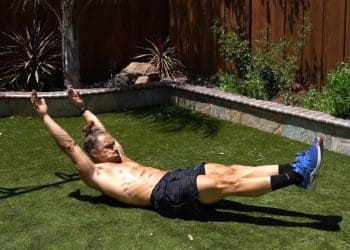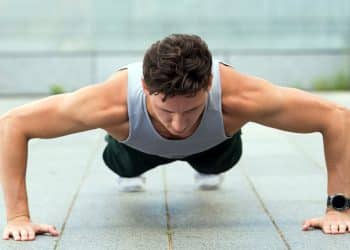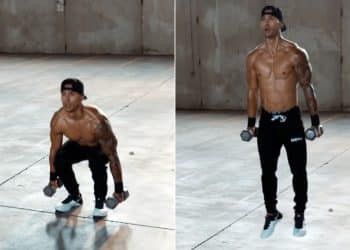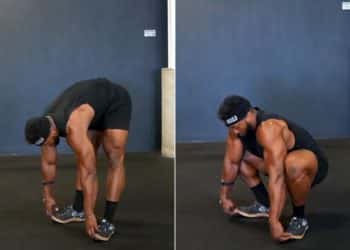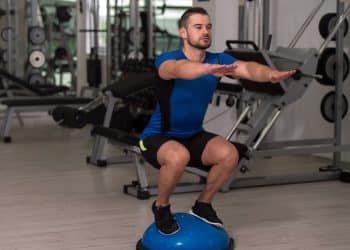The cable standing chest press is an underrated yet valuable push day technique offering distinct advantages over its lying, seated, and bodyweight press up counterparts. By simply performing the exercise fully upright on your feet while calling your legs, hips, and core muscles to back you up, you’re adding a functional, element that trains you in a way that makes you a more powerful human.
Think about it. Are sports performed while sitting on your ass or lying down on a comfy bench? Nope. You’re using all muscles in your body to transfer force from ground contact and upward through what’s called the kinetic chain of muscle function and performance.
But wait, there’s more… and benefits of standing exercises that hardly get mentioned. For people who suffer from vertigo, migraines, chronic stress, and other ailments, it can be challenging to lie down and perform a set of chest presses then get back up and not feel dizzy and lightheaded. This is where cable standing chest presses as well as seated exercises are useful.
Not to mention, cable presses are the best chest movement for pure muscle contraction as they allow for arm adduction past your body’s midline.
The cable standing chest press is a force to be reckoned with, and you’re leaving gains on the table by ignoring it.
Muscles Worked During Cable Standing Chest Press
A purely push focused exercise, the cable standing chest press is a tri-muscle movement. These are the three primary muscles worked during the movement.
Level Up Your Fitness: Join our 💪 strong community in Fitness Volt Newsletter. Get daily inspiration, expert-backed workouts, nutrition tips, the latest in strength sports, and the support you need to reach your goals. Subscribe for free!
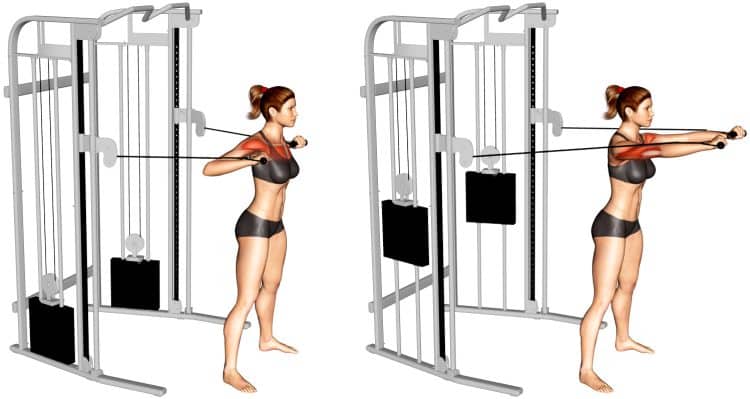
Pectoralis major: Typical of really any muscle group, there are multiple heads within each body part, and the chest has two major parts – clavicular (Upper chest), and sternal (Lower chest). Each distinct from the other, with the fibers of individual heads slanted in a unique direction, the upper head is best hit when the arm lifts up toward the neck, while the lower chest is best stimulated when the arms go from high to low.
It’s also possible to emphasize the inner chest fibers, and arm adduction is the key to max chest fiber activation!
Deltoid anterior: The perfect example of a tri-headed muscle, the deltoids have front, side, and rear fibers that flex the arm forward, lift it up sideways and pull it behind the body. However, all presses involve more front deltoids than the other two.
Triceps brachii: Also shaped with three heads, triceps muscles face the side and back part of the upper arm between the elbow and shoulder, crossing both joints. The biggest job of your triceps is to make the arm straight, aka elbow extension. However, because the long head runs into the shoulder at the back of the arm, it can help lift the arm back behind you.
How To Do The Cable Standing Chest Press
Before you can build beach-worthy pecs with a cable standing chest press, you need to make sure that both the cable machine setup, and your form match. But you also need to have access to two cable pulleys as this is a two arm variation. Although if you can only get to one side, don’t sweat it, you can do a cable standing one arm press. You can find an example of this variation later on in this guide.
Step 1: Slide the two pulleys to roughly the height of just below your lower chest. This way, when you naturally lean into the movement, the cable should be more in line with your mid to lower chest. Do a few practice reps with the lightest weight before you choose the working weight.
Step 2: Attach two single grip attachments to the cable pulleys. Use ones that are most comfortable and ergonomic for you.
Step 3: Choose the resistance, and make sure it’s the same for both pulleys. We recommend starting light with just the first one or two plates on the machine weight stack. You’ll know after the first rep if you need to add or drop the weight.
Step 4: Grip the handles in both hands if the pulleys are closely positioned. Or, if they’re far away from each other, grip one handle then walk over to the other side and grab the other one. Position your feet in a staggered stance with one leg in front of the other for optimal stability.
Step 5: Stand directly in the center between the two pulleys, bend your elbows, and take a few small steps forward so that the cables will stretch your pecs during the eccentric, non pressing portion of the lift. Keep your arms strong, and elbows at a 45-70 degree angle to your body, not lifted up high and level with your shoulders.
Step 6: Now contract your chest muscles, press your arms forward, and cross them over each other.
Step 7: Bend your elbows and allow your arms to retract behind your body until you feel a decent stretch in your chest muscles.
Step 8: Repeat step 6, but switch the position of your arms.
Perform the desired number of reps, switching the position of your arms each time you press.
Check out the following tutorial where famous trainer and fitness expert train Jeff Cavaliere (Athlean X YouTube channel) explains the demonstrates the version of cable standing chest presses we like most. You can watch the full video comparing cable standing chest presses to the barbell and dumbbell press. Or skip ahead to 2:32 for the cable standing chest press technique.
Pro Tips
- Different people will have their own setup for a cable standing chest press. Some like the pulley up higher so they can press at a downward angle. Others like the pulley to be the height of the chest so they can press the arms more parallel to the floor. There’s no perfect way to do it, as long as you’re doing it safely, and feeling the chest muscles working.
- Keep in mind, there’s no perfect, one size fits all technique for the cable standing chest press. It comes down to individual comfort which varies from person to person based on a different few factors. For example, someone with less healthy shoulders may need to keep the elbows lower than a more advanced exerciser.
- If you feel pain or discomfort in your shoulders, stop the exercise immediately. You could be using too much weight, bad technique, or are feeling the effects of a prior shoulder issue. Lighten the load significantly and work on your technique slowly.
Benefits of The Cable Standing Chest Press
Bet you never about some of these insane benefits of a cable standing chest press.
Bench press alternative
Exercises like the cable standing chest press are a suitable alternatives to a flat bench chest press. In fact, some exercisers forego the latter entirely, and despite what many would have you believe, you won’t go to training hell for your decision. But they’ll also carry over to your bench press.
And as we mentioned under the cable seated press variation later in this guide, people with blood pressure, and eye issues, chronic stress, vertigo, etc would rather opt for an upright, rather than flat lying exercise.
And the next benefit is something you can get neither from a barbell or dumbbell press, push-up, dip, and you can keep guessing but none tops this one…
Deepest chest contraction of any chest press
Because cable standing chest presses allow you to cross the arms past each other, aka arm adduction, you’ll tap into a portion of the chest that never gets full stimulation with other chest press variations.
In fact, you can feel the difference for yourself right where you are now. Just mimic a dumbbell press, and then replicate a press crossing your arms past each other, and squeeze your chest muscles during both styles. We guarantee you’ll feel a more intense contraction during the latter move.
That doesn’t mean you should stop doing dumbbell presses though. As we need that flat lying position combined with stabilizer activation to press the most weight, and challenge your chest the hardest.
Tension with adduction
What makes this exercise so beneficial is that not only do you have the ability to cross your arms, but the tension remains on your chest due to the design and function of the cable machine. Therefore, unlike using freeweights for some exercises where tension can be lost, it’s always there when you’re training with cables.
Add more spice to your training
Eating the same thing with the same taste all the time gets boring as we all know. Well, training is no different. Do the bench press every day, and you’ll be excited to use dumbbells, machines, and cable standing chest presses.
But it’s not just the boredom factor. Different exercises involve different techniques, ranges of motion, positions, challenges, and you get the picture.
Level Up Your Fitness: Join our 💪 strong community in Fitness Volt Newsletter. Get daily inspiration, expert-backed workouts, nutrition tips, the latest in strength sports, and the support you need to reach your goals. Subscribe for free!
An athletic variation
If you play ball, fight, or do any explosive, high intensity sporting activities, use the cable standing chest press in combination with exercises like jammer presses, landmine presses, and push-ups to increase your pushing power and athleticism.
What’s makes the cable standing chest press and especially the first two aformentioned movements (Jammer and landmine presses) unique? You have to stand up to do them. What’s so beneficial about this compared to a lying bench press or pec dec fly?
Well, you’re in an athletic stance for one, with feet staggered, upper body leaned slightly forward, and core engaged for stability. Seems awfully similar to competitive activities like blocking opponents, keeping the ball away from defense, maintaining distance in the octagon, and hopefully now you get the idea.
Common Mistakes During Cable Standing Chest Press
Cables, like free weights and other training methods are a double edged sword. They can give you unreal results, but using too much weight or the wrong technique can cause injuries. However, unless you’re training beyond your capabilities, and going at it blindly without learning the techniques, you’ll be safe, and get the gains you’re looking for.
Try to avoid these common bad training habits during cable standing chest presses.
Sacrificing form for weight
What’s wrong with training heavy? Absolutely nothing. In fact, you have to lift challenging loads to make strength gains. However, where the real issue lies is inexperienced exercisers using too much weight, and consequently, assistance from muscle groups that should be secondary.
As a result, you’re like the earth equivalent of an astronaut struggling to hold yourself down against the resistance. That’s not the way to train. It’s not only unsafe for your muscles as you’re less stable, but it causes unsymmetrical training between your left and right side, and gives the stabilizers a better workout than the target muscles.
So train heavy, but not to the extent that you cannot maintain position or press with a full range of motion.
Wrong setup/movement
The height of the cable pulley, and the direction of your press matters. Both go hand in hand, and depending on which part of the chest you’re trying to emphasize, you need to have your setup right. Otherwise, you’ll have an awkward, injury prone movement.
But for this basic chest press variation, you want to set up the pulley so that it’s right below lower chest level. That way when you lean into the movement, the cables resistance should line up with your arm position for an ergonomic press. That brings us to the next common mistake, although more significant for beginners.
Flaring the elbows too much
While it’s safer with lighter weight loads, a proper press is not done with the elbows flared out wide. Both for the protection of your shoulders, and optimal positioning for a strong press out. The elbows should be at a roughly 45-70 degree angle to your body.
Doing flys instead of presses
It’s easy to confuse the two, especially if you don’t really know what you’re trying to accomplish with cables. And we couldn’t blame you as flys feel insanely good on the chest. But don’t worry, you can do those too.
Variations and Alternatives of Cable Standing Chest Press
One of our favorite aspects of any exercise, you get to try out all the different variations, and alternatives with various angles and positions, techniques, and equipment. You’ll essentially work the same muscles, but not necessarily to the same degree. As some variations are better with lighter weights, a larger range of motion, etc.
These options are the best we have to offer.
Cable lying chest press
Cable lying chest presses give you more stability and consistency if you want to train heavier. The weight load naturally stabilizes your body on the bench, while you only need to focus on building those dream pecs. That’s not to say it’s superior, as both have their advantages, one being you not having to roll a bench over to cable machine. While training on your feet makes you better at generating total body force to deliver a strong press.
Cable seated chest press
Doing exercises seated is useful for many reasons and some that are never talked about. Like people with blood pressure problems, chronic stress, injuries, etc, can benefit from sitting rather than exerting themselves while standing, and lying down on a flat bench. Also a good movement for people who lack good balance and coordination.
So before someone says one variation is better than the other, remember, there are advantages to exercising in various positions.
One arm cable standing chest press
If you feel one arm lagging behind in a two arm cable standing press, we recommend doing some single arm sets to even out your strength and development.
However, the one drawback is that you need to make sure your feet, body, arm angle, grip, and range of motion are symmetrical when training your left and right side. Whereas in the bilateral, two arm version, you’re set up in position, and both arms are moving at the same time.
Resistance band standing chest press
If you’ve got nothing but $5-10 to spare for your home or outdoor workouts, definitely get a resistance band. Or better, buy a set for a few more Lincolns. It’s undoubtedly the best do-all piece of training tool that you can buy. And it’s your budget, minimalist answer to the cable machine, which most people don’t have access to unless they train at a gym.
You can set it up on a door anchor, or wrap it around a tree, or sturdy post of any type, and you have a standing chest press, fly, and a variety of back and shoulder exercises too.
You can wrap one end of your band around an object, or anchor it against your back (Better performed with heavier bands due to shorter length of the band when stretched) like the variation shown in the video example below.
Cable standing chest fly
If you like cable standing chest presses, you’re going to love the cable fly. Unquestionably one of the greatest feeling exercises that can do, there’s nothing like this focused stretch and chest pump combination. If you do it right, you’ll walk out of the gym feeling like a million bucks, and it’s quite addicting to be honest.
Plus, your core, legs, and back muscles will get residual gains from this movement as they’re engaged to help stabilize your body.
You do, however, need to ensure you’re doing two things right. Those are crossing your arms for maximal muscle contraction, and using an appropriate weight that challenges your chest more than your stability. You’ll need to find the right balance between optimal resistance, and technique.
The technique: Bend your elbows, and bring your arms out wide to stretch the outer pecs, then hug your imaginary friend, and squeeze your pecs as hard as you can.
Any other press
Whether it’s a free weight chest press, favorite push movement using a machine, or a push-up, all fall within a similar category. Compound, multiple joint exercises geared toward working all the push muscles (Chest, triceps, and deltoids) simultaneously using both arms to lift more, and stimulate a higher rate of strength and muscle gains.
FAQ’s
What are the best sets and reps to gain muscle mass and strength?
This depends entirely on your training experience. However, for the cable standing chest press in particular, we do not suggest using maximal weight loads that cause you to reach muscular failure before 6 repetitions.
Why?
Because unlike a cable standing overhead shoulder press, you’ll have less stability and require more total body engagement to keep you from being pulled back by the pulleys.
Although, if you have the right setup, which can vary depending on how you use the machine, you can certainly use more weight. But many will severely sacrifice their form for weight, using sloppy technique, and too much of the other muscles.
How should I program the cable standing chest press?
There’s no perfect way to add this movement in your chest training workouts. However, we can offer you some training tips that may help your push day planning.
Here are some ideas for including cable standing chest presses in your pec sessions.
Drop sets – A fantastic and highly recommended training method. The idea is to perform a few reps with a heavy weight until you get close to or reach muscular failure. Then, you immediately lower the weight, and keep pumping out reps until you hit failure again. You can do this for a desired number of repetitions, or until you make it to the last plate on the cable stack.
Circuit chest workout – A ring around the posey, you’ll select several chest exercises and perform one set of each back to back until you’ve complete all. Then you’ll rest, and repeat once or twice more.
Replace your normal go to compound chest movement – If you typically do the bench press first, try something different and switch it out with the cable standing chest press next time. You may feel that you can better pre-activate your pecs by stretching them with a different technique and angle. Improving your mind-muscle connection which could cause you to have a mindblowing chest workout.
What is the advantage of a cable standing chest press over a freeweight bench press?
Cable standing press offers an upright, standing version of the conventional bench press with adduction, which makes it more functional, and a great alternative for those who experience discomfort from exerting themselves in a flat lying position.
What should I do if my shoulders start hurting during the exercise?
Do you have pre-existing shoulder issues. If you’ve ruled this out, it could be your arm position, allowing your arms to retract too far back during the stretch, placing stress on the shoulders, or you may be using too much weight.
Wrapping Up
The cable standing chest press isn’t just an fill-in for a conventional free weight bench press. It carries a different set of benefits such as arm adduction, a unique training style, and athletic transfer which can help you to become more powerful in contact sports, lifting events, and so much more.
With that being said, it’s the perfect complement to your free weight presses, push-ups, fly’s and all of the necessary chest building basics. But, you can certainly give it priority when you want a change up from the usual compound presses.
Interested in measuring your progress? Check out our strength standards for Bench Press, Push Ups, Cable Fly, and more.



